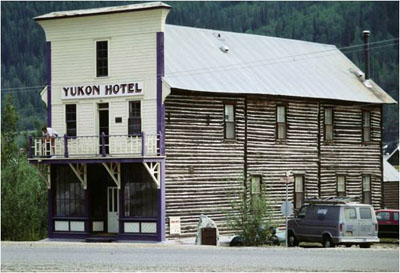Yukon Hotel National Historic Site of Canada
Dawson, Yukon Territory

Side View
© ©Permission Guy Masson
Address :
First Avenue, Dawson, Yukon Territory
Recognition Statute:
Historic Sites and Monuments Act (R.S.C., 1985, c. H-4)
Designation Date:
1982-06-12
Dates:
-
1898 to 1898
(Construction)
-
1898 to 1903
(Significant)
Event, Person, Organization:
-
Klondike Gold Rush
(Event)
-
J. E. Binet
(Architect)
Other Name(s):
-
Yukon Hotel
(Designation Name)
-
Binet Block
(Other Name)
Plaque(s)
Existing plaque: On a rock beside the building First Avenue, Dawson, Yukon Territory
When it was built in the fall of 1898, the Binet Block stood at the southern end of a business district extending north to King Street. A two-storey log building with a façade of milled lumber, it was typical of commercial structures built at the height of the gold rush. The lower floor with its large windows was meant for commercial use, the upper for residential. Between October 1898 and October 1900, the Federal Government rented it for offices. During the next fifty-seven years, it was used as a hotel, under such varied names as The Miner's Rest, The Freeman, and The Yukon Hotel.
Description of Historic Place
The Yukon Hotel is a small wooden false-front building on First Avenue, ''Dawson City’s'' major street at the height of the Klondike Gold Rush. Its log side walls and pitched roof are visible from Third Avenue which runs beside its site.
Heritage Value
The Yukon Hotel was designated a national historic site of Canada in 1982 because: it was typical of commercial structures built at the height of the Klondike Gold Rush.
The heritage value of the Yukon Hotel resides in its representation of typical commercial structures built at the height of the Klondike Gold Rush as illustrated by its site, setting and composition. Built in 1898 by J. E. Binet, the Yukon Hotel was first known as the Binet Block. Initially rented for Government Offices, it became a hotel in 1900 and served as such under a variety of names until 1957. Today it has been restored as part of Dawson Historical Complex National Historic Site of Canada.
Source: Historic Sites and Monuments Board of Canada, Minutes, 1982.
Character-Defining Elements
Key elements that contribute to the heritage value of this site include: its siting flush to the sidewalk on a major street within downtown ''Dawson City''; its boom town architectural vocabulary translated as a rectangular footprint, two-and-a-half pitched roof massing, behind a three-storey false-front; its log construction with milled lumber façade; the simple articulation of the three-bay façade with central entry between large, multi-pane commercial windows, second-storey balcony and false window at third-storey level; its wooden detailing, notably the ornate balcony railing and brackets; the functionally driven arrangement of apertures on all other elevations; its use of pressed metal as a roofing material; the surviving evidence of original interior layout, workmanship and materials.